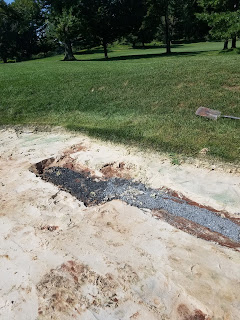Once again, Mother Nature wins. We have been dealing with
the water coming out of the ground and across the cart path on #12 for too
long. We will be starting a project soon to capture it in the rough, get it
into a drain pipe and out through a bunker drain.
First, we will trench a drain line perpendicular to the flow
coming from 11 towards 12 fairway. All water flowing down towards 12 will cross
this new drain and be diverted into a drain pipe. Our expectation is that there
is an old, existing drain pipe that is still functioning somewhere in this
vicinity, to the left of the cart path (we found the old pipe on the other side
of 12 fairway already). Once we explore and (hopefully) find this old pipe, we
will attach our new pipe to it and this will take the water across the fairway.
Next, starting in the holes we have already dug on the right
side of #12, we will add new pipe. This is where our initial attempt to
diagnose the issue started. The outflow side of this old pipe is no longer
working from where our hole is, downward. We will tap in here with a new pipe
and trench it over towards the fairway bunkers. We will then tap into the
bunker drainage, which we know works, to move the water out. This is not a day
long project, so please be patient with the work and guaranteed mess. We will
get it wrapped up as quickly as possible.
While this has been an abnormally wet summer, we know from
the past that water will come from this same area to the left of 12 even in
drier times. This season Mother Nature has pushed to the limit what we can
handle, so we have to make the adjustment.
Etiquette Reminder of the Month
Remember to please fill your divots both on the tees and in
the fairways. No one wants to land in a divot in the fairway, but if a ball
does happen to end up there, a sand filled divot is much better than a hole.
Also, as part of a Golf Committee initiative to improve course
etiquette, we have included links to videos teaching proper on course
etiquette. Please take a moment to watch:
See you on the course!
Joe
jvillegas@bwrc.org




